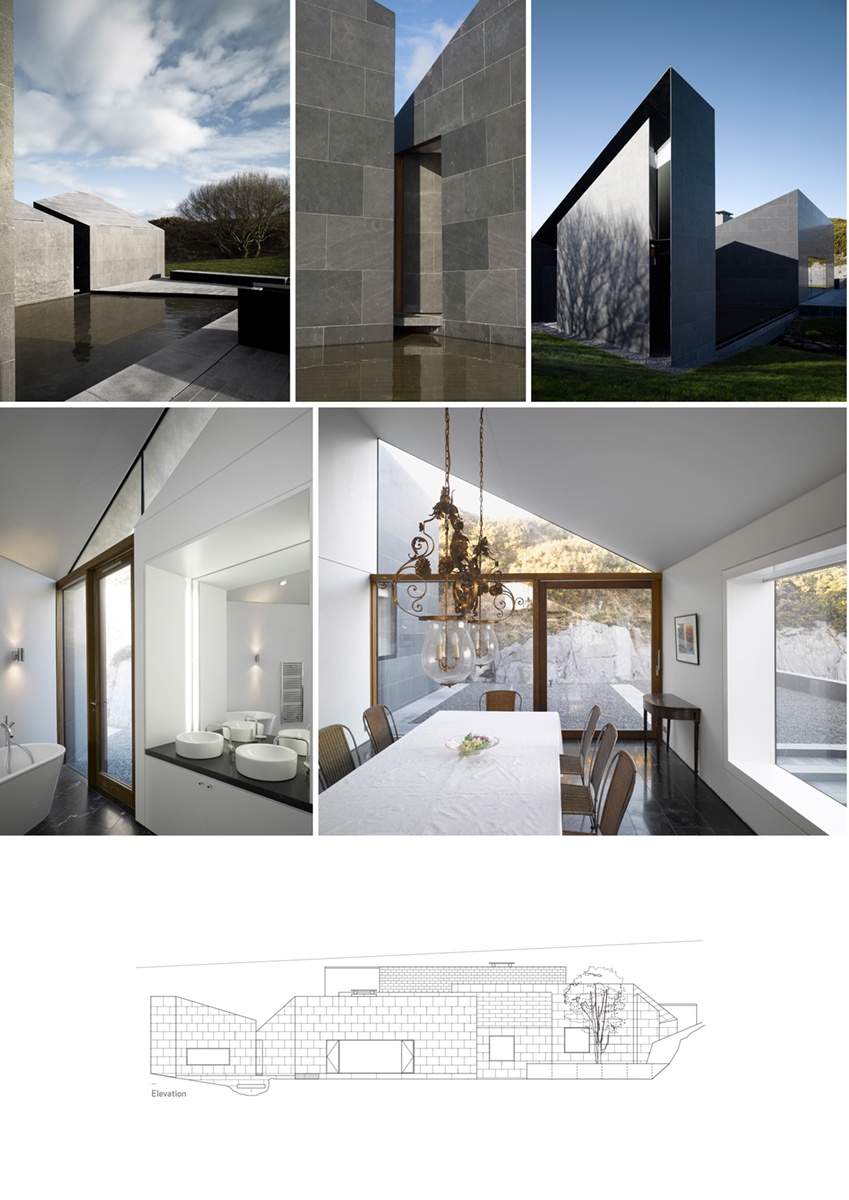An Acropolis of Ideas - RIAI Annual Review
Issue 2012/13
Text John Hegarty
Images Nick Gutteridge, Nick Kane
I visited Spanish Cove on a day of sunshine and a clear blue sky. I wasn’t aware of the sea as I approached and saw first the simple flush white geometry of the remodelled original house. Before entering, I looked to the ground and noticed the impeccable detailing of linear paving against a linear narrow drain.
This is a house of three limestone-clad mono pitch blocks running parallel to a traditional form, minimally detailed white-painted rendered house. On plan, the separate blocks seem to slide apart to allow the rooms behind to address the view. Minimal glazed elements connect each block and views are encouraged between the blocks or prevented by the deliberate location of chimney stacks.
From the entrance lobby space I walked right towards the light and the wide hall stretching to the dining space was revealed. The hall forms a strong axis that runs through three distinct spaces. To extended door height, there is flush teak panelling on the walls of the hall in the manner of Mies van der Rohe. There is shadow detail around the doors and between and below the panels to the limestone floors.
Moving into the next space, I saw outside through a gap between the buildings. I was separated from the outside by a minimal glass wall and ceiling. Gradually the building came together in my mind with pieces of information I gather from looking out and recovering from that daydream to focus within again. When I came to the main panelled sitting-room, I saw out to a bank of yellow gorse through a high window to my left before taking in the open expanse of the landscape that falls to the sea.
I opened the door to the right of the angled end-wall and found it led to the outside. It was very heavy and, when open, I saw it clad in limestone. Outside on a small stone bridge, there is a door in front of me that leads to another fragment of the building. In this space, water sits in a definite pool that relates to a slot cut from the geometry of the last block of the house. It becomes apparent here that this relates to a stream that runs under the house and down the garden into the sea.
Outside, I saw the limestone-clad roofs and walls. They are seamlessly joined. The gable ends of the mono pitch blocks are open and glazed with deep angled recesses expressing the angled thickness of the walls that come to a point. I looked at how water is directed from the roof. There is one recessed gutter with no visible outlet for each mono pitch that runs above all doors and windows but not to the full length of the roof. Just as is necessary and no more that might interrupt the purity of the building form.
Walking around the building externally, the high level of consideration of the formal aspect of the house is revealed in conjunction with the minute consideration for detail and the uncompromising follow through of ideas. I walked around the house clockwise from the courtyard and found the cool of the north elevation and the space created by the proximity of the rock face makes me more alert to the space. The building appears high and sharp as I moved slowly down the stepped paving. I stepped down into the north courtyard. I examine detail and the route for rain water, wherever I am.
The site is a landscape of layers and the house is a building of layers. The carpet of peat that is the site between the peaks that create this miniature valley sits on rock that reveals its craggy fingers as it merges with the sea. First there is the rock, then the peat layer, then perpendicular to the rock run the linear blocks of the house and then against this runs the axis through the house and the rising ridges of linear rock peaks either side of the site.
Viewed from above, the house reveals its elemental form. The scale of the building in the landscape may be separated from the domestic by its material expression. The scale of the forms relates to the traditional form of the narrow gabled long houses that enclose many Irish farm courtyards. In addition to the scale relating to local context, there is the strong perception of there being no scale and the house may be appreciated easily as a formal and abstract object. Within the plan I see much symmetry and then the breaking of symmetry; demonstrating more reference to the traditional farmhouse which has classicism in its roots. Symmetry created is skilfully broken in a house designed to look out. The simplicity of the house and the formal, flush and minimal detail allows the house to sit in deference to the gorse-covered rock ridges and the peaty lawn in the trough between.
The house sits on a solid flat limestone plinth of paving and water pools above the undulating line of the soft landscape. It is an acropolis. It is a settlement in the landscape. It creates rules for its own development and breaks them as it approaches the obstacle of the landscape in the same manner as a planned ancient Greek city or the plan of an Irish farmyard of the 18th or 19th century. In its detail, its form and the location of the buildings, this house demonstrates a clear and subtle expression that is specific to Ireland and to West Cork. It embodies a clear intellectual understanding of context without compromise of architectural intent.
